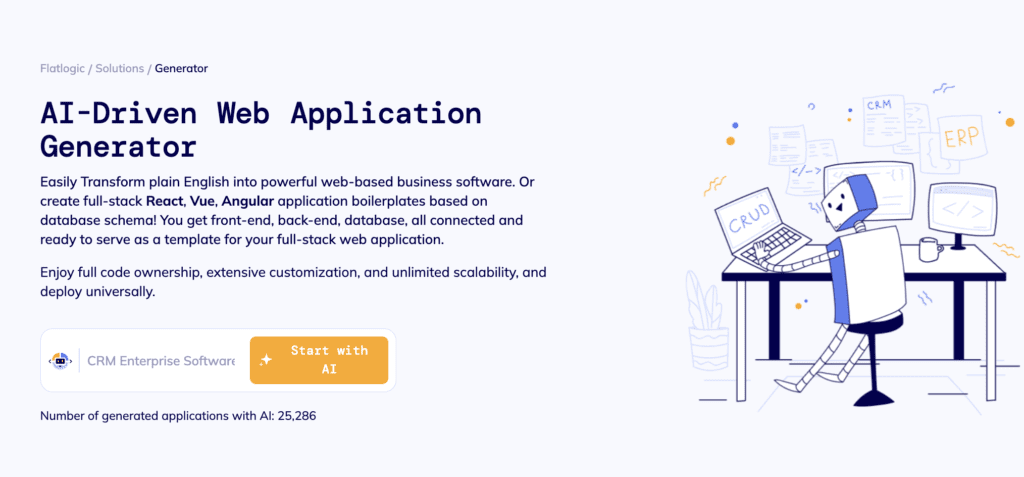
Top 5+ Low-Code/No-Code Tools [Based On Flatlogic Research]
September 16, 2024Why waste hours coding from scratch when the future of app development is literally at your fingertips? Discover the game-changing low-code/no-code tools that can turn your ideas into reality faster than you ever imagined.
Are you wondering which Low-code/No-Code platforms are truly worth your time? Are you curious about how these tools stack up against traditional coding? Or perhaps you’re asking: Can these platforms handle the complexities of my business needs? As Bill Gates once said, “The first rule of any technology used in a business is that automation applied to an efficient operation will magnify the efficiency.” But which tools will help you achieve that?
The explosion of Low-Code/No-Code platforms is both a blessing and a curse. While these tools promise to democratize app development, they also create a new problem: how to choose the right one? A recent study by Flatlogic highlighted that over 60% of developers struggle with selecting the most suitable low-code/no-code platform due to the overwhelming number of options available. This is more than just a technical challenge it’s a strategic decision that could make or break your next project.
You should trust the insights in this article because they come from an industry with over a decade of experience in software development and a deep understanding of both traditional coding and low-code/no-code tools. My insights are grounded in real-world experience and backed by data.
By reading this article you will know exactly which low-code/no-code tools are leading the pack, how they can streamline your development process, and what potential pitfalls to watch out for. Whether you’re a seasoned developer or a business leader looking to empower your team, this guide will equip you with the knowledge you need to make informed decisions.
What Are Low-Code/No-Code Tools?
Low-code/No-Code tools represent a revolutionary shift in the software development landscape. These platforms allow users to build applications with minimal to no coding required, making it possible for even those with limited technical expertise to create functional and scalable software solutions.
Definition and Scope
Low-code platforms provide a visual development environment where users can drag and drop components to design applications, with the option to write code for more complex functionality. No-code platforms go a step further, enabling users to create apps entirely through visual interfaces without writing any code at all. These tools are designed to accelerate the development process, reduce the need for specialized coding knowledge, and empower a broader range of individuals—from business analysts to seasoned developers—to contribute to software creation.

History and Evolution
The concept of Low-Code and No-Code isn’t entirely new. It has roots in earlier tools like Visual Basic and Microsoft Access, which allowed for some degree of visual programming. However, the modern era of low-code/no-code tools began in earnest in the mid-2010s, driven by the increasing demand for faster and more agile development processes. Companies needed to adapt quickly to changing market conditions, and traditional development cycles were often too slow to keep up. Low-code/no-code tools emerged as a solution, offering a way to streamline development and reduce dependency on large, specialized development teams.
Importance in Modern Development
In today’s fast-paced business environment, time is of the essence. Companies that can quickly develop and deploy applications have a significant competitive advantage. Low-code/no-code tools are critical in this context because they reduce the time it takes to bring an idea from concept to deployment. By lowering the barriers to entry for software development, these tools enable businesses to innovate rapidly, respond to customer needs more efficiently, and reduce costs associated with traditional development.
Moreover, low-code/no-code tools support the growing trend of “citizen development,” where non-technical users within organizations can create their applications to solve specific problems or optimize workflows. This democratization of software development not only increases productivity but also fosters a culture of innovation across all levels of a company.
In essence, low-code/no-code tools are not just an alternative to traditional coding—they are becoming an essential part of the modern development toolkit, enabling businesses to stay competitive in an increasingly digital world.
Criteria for Evaluating low-code/no-code Tools
Choosing the right Low-code/No-Code tool can be a game-changer for your development process, but with so many options on the market, it’s essential to evaluate them based on key criteria that align with your specific needs. Below are the most critical factors to consider when assessing low-code/no-code platforms:
1. Ease of Use
The primary appeal of low-code/no-code tools is their ability to simplify application development, so ease of use is paramount. A good low-code/no-code platform should have an intuitive, user-friendly interface that enables users of varying technical skill levels to get started quickly. Look for tools that offer drag-and-drop functionality, pre-built templates, and comprehensive tutorials. The goal is to minimize the learning curve so that both technical and non-technical users can create applications efficiently.
2. Customization and Flexibility
While ease of use is important, the ability to customize and extend applications is equally crucial. Evaluate how well the platform allows for customization—can you easily add custom code if needed? Does the tool support complex logic and workflows, or is it limited to basic functions? Flexibility in design and functionality ensures that the tool can grow with your needs, allowing you to create applications that are not only functional but also tailored to your specific business requirements.
3. Integration Capabilities
No application exists in a vacuum it must integrate seamlessly with other systems and services. When evaluating low-code/no-code tools, consider their integration capabilities. Can the platform easily connect with your existing software, databases, and APIs? Look for tools that offer robust integration options, including pre-built connectors for popular services like Salesforce, AWS, or Google Cloud. This ensures that your new applications can operate within your existing tech ecosystem without requiring significant additional work.
4. Cost-Effectiveness
The financial aspect of adopting a low-code/no-code platform cannot be overlooked. Evaluate the pricing models of the tools you’re considering—do they charge per user, per application, or based on usage? Some tools may have hidden costs, such as fees for additional features or higher levels of support. Compare these costs against your budget and the potential ROI of faster development times and reduced reliance on highly specialized developers. The most cost-effective tool will balance affordability with the features and support you need.
5. Community and Support
The level of support and the strength of the user community can significantly impact your experience with a low-code/no-code tool. A vibrant community often means more resources, such as forums, tutorials, and third-party plugins, which can help you overcome challenges faster. Additionally, consider the quality of the platform’s official support—do they offer 24/7 assistance, detailed documentation, and timely updates? Strong community and support structures ensure that you’re never stuck for long and can maximize the tool’s potential.
6. Security and Compliance
As businesses increasingly rely on low-code/no-code tools for critical applications, security and compliance become vital considerations. Assess whether the platform meets industry standards for data protection, such as GDPR, HIPAA, or SOC 2 compliance. Does the tool offer robust security features, such as encryption, user authentication, and role-based access control? Ensuring that the low-code/no-code tool aligns with your security and compliance requirements is essential for protecting your data and maintaining customer trust.
7. Scalability
Finally, consider the tool’s ability to scale with your business. Can the platform handle an increasing number of users, more complex applications, and larger data volumes? Scalability ensures that your investment in a low-code/no-code tool will pay off in the long term, as it can grow alongside your business without requiring a switch to a more powerful (and potentially more complex) platform later on.
By carefully evaluating low-code/no-code tools against these criteria, you can select a platform that not only meets your current needs but also positions you for future success. The right tool will empower your team to build, deploy, and maintain applications more efficiently, driving innovation and business growth.
Top low-code/no-code Tools in 2024
As we move into 2024, the Low-code/No-Code market continues to evolve, with significant shifts in user preferences and tool adoption. According to the latest research conducted by Flatlogic, there’s a clear trend towards the popularization of visual and drag-and-drop builders, with over 50% of respondents preferring these tools to simplify their development lifecycle. This year marks the first time we’ve measured this preference, and the results are telling: decision-makers are leaning heavily towards visual builders, with 57.69% showing a preference, while text-to-app generators, which often incorporate AI, also garnered significant interest at 31.73%.
Here’s a look at the top low-code/no-code tools based on our 2024 research:

Leading the charge in the text-to-app generator space, GPT Engineer has emerged as the most popular tool in 2024, capturing 30% of the votes from our respondents. GPT Engineer leverages AI to automate significant parts of the coding process, making it especially appealing to beginners and those looking to expedite development. It’s a tool that stands out for its ability to generate code based on text input, bridging the gap between no-code and more traditional development methods.
- Target Audience: Beginners to intermediate developers, and startups.
- Pricing: Free tier available premium plans start at $49/month.
- Key Features: AI-driven code generation, natural language processing, customizable templates.
- Pros: Fast development, reduces manual coding, easy to use for non-developers.
- Cons: Limited customization, may require further refinement by experienced developers.

The Flatlogic Generator follows closely, securing 24% of the votes. While this tool’s ranking might come with a grain of bias—given our direct involvement—it remains a powerful platform for rapidly building web applications. The Flatlogic Generator is particularly noted for its balance between ease of use and customization, making it a popular choice across all experience levels. Its drag-and-drop interface coupled with code generation capabilities offers a flexible solution for both novice and experienced developers.
- Target Audience: All experience levels, especially startups and SMEs.
- Pricing: Free trial available pricing starts at $99/project.
- Key Features: Visual interface, automated backend generation, integration with major frameworks.
- Pros: Easy setup, good for quick MVPs, supports popular frameworks.
- Cons: Limited customization in the free version, biased towards use cases that fit its templates.

Rounding out the top three is FlutterFlow AI Gen, a tool that integrates AI with Flutter’s already robust framework to offer a powerful low-code solution. FlutterFlow AI Gen is particularly popular among users who appreciate the flexibility of Flutter combined with the efficiency of low-code development. It’s a tool that appeals to both developers looking to accelerate their workflow and those new to app development.
- Target Audience: Intermediate to advanced developers, mobile app developers.
- Pricing: Free tier premium plans start at $30/month.
- Key Features: AI-assisted design, Flutter integration, real-time collaboration.
- Pros: Strong Flutter support, AI-driven efficiency, scalable.
- Cons: Steep learning curve for non-technical users, limited customization compared to full-code Flutter apps.

Despite being traditionally associated with website building, WordPress continues to dominate the low-code/no-code landscape as the most popular no-code tool for the third consecutive year. However, it’s worth noting that while WordPress is user-friendly, it requires some coding skills for advanced customization, which somewhat undercuts its no-code philosophy. Nevertheless, WordPress remains a go-to option for those looking to build functional websites without diving deep into code.
- Target Audience: Bloggers, small businesses, content creators.
- Pricing: Free premium plans start at $4/month.
- Key Features: Extensive plugins, theme customization, content management system.
- Pros: Highly extensible, large community, SEO-friendly.
- Cons: Advanced features require coding and security concerns with plugins.

Bubble is another tool that has maintained its popularity, especially among users with 0 to 1 years of experience. Its strength lies in its ability to empower users to create complex web applications without writing code. Despite its steep learning curve, Bubble remains a favorite for those who prioritize customization and scalability in their no-code projects.
- Target Audience: Entrepreneurs, startups, early-stage app developers.
- Pricing: Free tier paid plans start at $25/month.
- Key Features: Visual app builder, database management, third-party integrations.
- Pros: Great for building complex apps, strong community support, scalable.
- Cons: Steep learning curve, performance can vary with app complexity.

Among more experienced developers, particularly those with over 10 years of experience, Webflow remains a strong contender. It’s a tool that offers more advanced design and development capabilities, appealing to professionals who need the flexibility of custom code but appreciate the speed that a low-code platform provides.
- Target Audience: Designers, front-end developers, digital agencies.
- Pricing: Free trial available premium plans start at $16/month.
- Key Features: Responsive design, CMS capabilities, eCommerce support.
- Pros: Professional-grade design tools, excellent for SEO, strong community.
- Cons: More expensive than other tools, steeper learning curve for full customization.
The low-code/no-code market is still highly fragmented, with no single tool emerging as a clear leader. More than 32% of respondents in 2024 indicated they would not use any low-code/no-code tools to build web applications, highlighting the ongoing debate between the convenience of low-code/no-code solutions and the control offered by traditional development methods. This fragmentation suggests that while these tools are gaining popularity, there’s still a significant portion of the development community that prefers more conventional approaches, especially among seasoned developers.
As the industry continues to mature, we expect to see further innovations in both visual builders and text-to-app generators, driven by AI and increasing user demand for flexible, scalable, and efficient development tools. Whether you’re a novice developer looking to get started quickly or a seasoned pro seeking to streamline your workflow, these top low-code/no-code tools offer a range of solutions to meet your needs in 2024.
Potential Pitfalls and Challenges
While Low-code/No-Code tools offer an appealing shortcut to app development, they are not without their challenges. As these tools gain popularity, it’s crucial to understand the potential pitfalls that could impact your project’s success. Here’s a look at some of the key challenges you may encounter when using low-code/no-code platforms:
1. Limited Customization and Flexibility
One of the biggest drawbacks of low-code/no-code tools is their inherent limitation in customization. While these platforms excel at quickly generating basic applications, they often fall short when more complex or unique features are required. Developers may find themselves hitting a wall where the tool’s capabilities end and traditional coding must begin. This can lead to increased development time and costs, especially if the tool doesn’t support seamless transitions to custom code.
2. Scalability Issues
low-code/no-code tools are fantastic for building prototypes or small-scale applications, but scaling these applications to handle larger user bases or more complex functionality can be problematic. As the application grows, the performance may degrade, or the platform’s limitations become more apparent, requiring a complete rebuild using more traditional development methods. This scalability issue can be particularly challenging for startups or businesses that experience rapid growth.
3. Vendor Lock-In
Many low-code/no-code platforms use proprietary technology that can lock users into a specific vendor. This means that once you’ve built your application on a particular platform, migrating to another platform or moving away from low-code/no-code altogether can be difficult and costly. The reliance on a single vendor for updates, security patches, and ongoing support can also pose risks if the vendor’s priorities shift or if they discontinue the service.
4. Security Concerns
Security is a critical concern in any application, and low-code/no-code tools can sometimes fall short in this area. Since these platforms abstract much of the underlying code, developers have less control over security measures. This can lead to vulnerabilities that are harder to identify and address. Moreover, because low-code/no-code platforms are often used by less experienced developers, best security practices might not always be followed, increasing the risk of breaches.
5. Learning Curve and Expertise
Although low-code/no-code tools are marketed as easy to use, there is still a learning curve involved, especially for users with no development background. Understanding the limitations, best practices, and how to effectively use these tools requires time and effort. Additionally, as projects grow in complexity, even experienced developers may struggle to push the tools beyond their intended use cases, requiring specialized knowledge to work around limitations or integrate with more advanced technologies.
6. Integration and Compatibility Issues
Integrating low-code/no-code-built applications with existing systems or third-party services can be tricky. While many platforms offer a range of integrations, they may not support all the services your application needs. Custom integrations can be difficult to implement, especially if the platform doesn’t provide adequate support for external APIs or legacy systems. This can result in additional development overhead or compromise the functionality of your application.
7. Hidden Costs
While low-code/no-code tools often present themselves as cost-effective solutions, there can be hidden costs that catch users off guard. These might include fees for premium features, higher charges for scaling applications, or the cost of additional services like hosting or advanced support. Over time, these costs can accumulate, making the solution less affordable than initially anticipated.
8. Dependency on Platform Updates
Finally, users of low-code/no-code tools are at the mercy of the platform’s update schedule. If the platform fails to keep up with new technologies, bugs, or security vulnerabilities, your application could be left behind. Moreover, updates that change the platform’s functionality could inadvertently break your application or force you to adapt to new workflows, adding to your workload.
In conclusion, while low-code/no-code tools offer a range of benefits, they are not a one-size-fits-all solution. Being aware of these potential pitfalls and challenges allows you to make more informed decisions and better prepare for the realities of using low-code/no-code platforms in your development projects.
Future Trends in low-code/no-code Development
The Low-code/No-Code landscape is rapidly evolving, with new trends shaping how these platforms are developed and utilized. As we look forward to the future, several key trends are expected to redefine the capabilities and adoption of low-code/no-code tools, pushing the boundaries of what can be achieved without traditional coding.
1. Integration of AI and Machine Learning
One of the most significant trends in low-code/no-code development is the integration of Artificial Intelligence (AI) and Machine Learning (ML). As AI technology advances, it is becoming increasingly embedded within low-code/no-code platforms, enabling more intelligent automation, personalized experiences, and predictive analytics. These enhancements allow non-developers to leverage complex AI-driven features such as natural language processing, automated decision-making, and data-driven insights, making application development even more accessible and powerful.
2. Expansion of Text-to-App Generators
Text-to-app generators are poised to become more prevalent as they combine the simplicity of no-code with the sophistication of AI. These tools allow users to describe what they want in plain language, and the platform generates the necessary code or components. As natural language processing improves, we can expect these tools to become even more intuitive, bridging the gap between non-technical users and complex application development. This trend could significantly reduce the time and expertise required to bring ideas to life.
3. Greater Focus on Customization and Extensibility
As the demand for more tailored solutions grows, low-code/no-code platforms are expected to offer greater customization and extensibility. Future iterations of these tools will likely provide more advanced options for customizing the generated code or adding bespoke features. This trend aims to address one of the current limitations of low-code/no-code tools: their inability to meet specific, complex requirements. By offering more extensible frameworks, low-code/no-code platforms will cater to a broader audience, including developers who need the flexibility to create highly customized applications.
4. Enhanced Collaboration Features
Collaboration is becoming increasingly important in the development process, and low-code/no-code platforms are beginning to reflect this need. Future low-code/no-code tools are expected to include more robust collaboration features, enabling multiple team members, including developers, designers, and business stakeholders, to work together seamlessly. Real-time collaboration, version control, and integrated communication tools will become standard, making it easier for teams to build and iterate on applications collectively, regardless of their physical location.
5. Rise of Vertical-Specific low-code/no-code Platforms
As the low-code/no-code market matures, we anticipate the emergence of more vertical-specific platforms tailored to industries like healthcare, finance, education, and e-commerce. These specialized tools will come pre-configured with industry-specific components, templates, and compliance features, allowing users to quickly build applications that meet the unique requirements of their sector. This trend will drive adoption in industries where generic low-code/no-code tools may not currently meet specific regulatory or operational needs.
6. Increasing Adoption in Enterprise Environments
While low-code/no-code tools have traditionally been seen as solutions for startups and small businesses, there’s a growing trend toward their adoption in enterprise environments. Large organizations are beginning to recognize the potential of low-code/no-code platforms to accelerate digital transformation initiatives, reduce development backlogs, and empower non-technical staff to contribute to the application development process. As a result, future low-code/no-code platforms will likely include enterprise-grade features such as enhanced security, scalability, and integration capabilities.
7. Greater Emphasis on Education and Training
As low-code/no-code tools become more powerful and complex, the need for education and training will grow. We can expect to see more resources, courses, and certifications aimed at helping users maximize the potential of these platforms. This trend will be crucial in ensuring that users not only adopt low-code/no-code tools but also use them effectively to achieve their goals. As a result, platform providers will increasingly invest in creating comprehensive learning ecosystems around their tools.
8. Evolving Role of Developers
The role of developers is also expected to evolve alongside the growth of low-code/no-code tools. While these platforms reduce the need for manual coding, developers will play a crucial role in extending low-code/no-code applications, integrating them with other systems, and ensuring they meet high standards of performance and security. Developers will increasingly act as advisors and architects, guiding the strategic use of low-code/no-code tools within organizations and ensuring that these tools are used to their full potential.
In conclusion, the future of low-code/no-code development is bright, with exciting trends that promise to make these platforms even more powerful, accessible, and versatile. As AI, customization, and collaboration features continue to advance, low-code/no-code tools will not only democratize application development but also transform how businesses and individuals bring their digital ideas to life.
Conclusion
This article explores the growing role of Low-code/No-Code tools in modern software development. We broke down what these tools are, and how they differ, and reviewed the top tools for 2024. We also discussed key factors to consider when choosing a platform, challenges you may face, and future trends in low-code/no-code development.
As these tools continue to improve, they offer businesses the opportunity to accelerate development, reduce costs, and empower teams to innovate without heavy coding. However, the success of your project depends on choosing the right tools and understanding their strengths and weaknesses.
If you’re ready to harness the power of low-code/no-code tools but need help choosing the right platform or optimizing your development process, Flatlogic is here to help. With our expertise in both traditional and low-code/no-code development, we can provide customized solutions to meet your business needs. Whether you’re building a new application or refining your current process, contact us to see how we can help you bring your ideas to life faster and more efficiently.
